Forms Of Energy - Mechanical Energy - Electrical Energy - Chemical Energy - Nuclear Energy - Thermal Energy
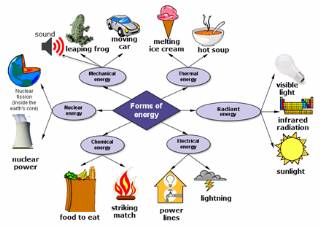
We associate energy with devices whose inputs are fuel based such as electrical current, coal, oil or natural gas; resulting in outputs such as movement, heat or light.
Unit of energy is the Joule (J). The rate of producing energy is POWER which has the unit of Joule per second or the Watt (W9.
There are FIVE forms of Energy:
- Mechanical Energy
- Electrical Energy
- Chemical Energy
- Nuclear Energy
- Thermal Energy
These energy forms are discussed in the following sections.
Mechanical energy
This type of energy is associated with the ability to perform physical work. There are two forms in which this energy is found; namely potential energy and kinetic energy.
Potential energy
As the name implies is contained in a body due to its height above its surroundings, examples such as the gravitational energy of the water behind a dam, and the energy stored in batteries. Potential Energy = mass x acceleration due to gravity (9.81) x height above datum
Ep = m x g x h
The energy produced by one kilogram of water falling from a height of 100m above ground is a potential energy, which can be calculated as follows:
Potential Energy = mass x acceleration due to gravity x height above datum
Ep = 1 x 9.81 x 100 = 981 J/kg
Kinetic energy
Kinetic energy is related to the movement of the body in question. Examples of KE such as the flywheel effect and the energy of water flowing in a stream.
Kinetic Energy = ½ mass x velocity squared
Ek = ½ x m x v2
The water stream in a river flowing at a velocity of 2 m/s has a kinetic energy of:
Kinetic Energy = ½ mass x velocity squared = ½ x 1 x (2)2 = 2 J/kg
Electrical energy
This type of energy as the name implies is associated with the electrons of materials. Electrical energy exists in two forms:
Electrostatic electricity
This type of electrical energy is produced by the accumulation of charge on the plates of a capacitor. Charles Coulomb first described electric field strengths in the 1780's. He found that for point charges, the electrical force varies directly with the product of the charges. The greater the charges, the stronger the field. And the field varies inversely with the square of the distance between the charges. This means that the greater the distance, the weaker the force becomes. The formula for electrostatic force, F, is given as:
F = k (q1 X q2) / d2
Where q1 and q2 are the charges, d is the distance between the charges. And k is the proportionality constant which depend on the material separating the charges.
Electromagnetic energy
This type is produced with a combination of magnetic and electric forces. It exists as a continuous spectrum of radiation. The most useful type of electromagnetic energy comes in the form of solar radiation transmitted by the sun that forms the basis of all terrestrial life.
Chemical energy
This type of is associated with the release of thermal energy due to a chemical reaction of certain substances with oxygen. Burning wood, coal or gas is the main source of energy we commonly use in heating and cooking.
Calculation of chemical energy
The energy liberated from the combustion of a given mass of fuel, with a known calorific value in a combustion chamber of known efficiency is given by:
Chemical Energy = Mass of fuel x calorific value x efficiency of combustion
Nuclear energy
This energy is stored in the nucleus of matter, and is released as a result of interactions within the atomic nucleus.
There are three nuclear reactions:
Radioactive decay:
In which one unstable nucleus (radioisotope) decays into a more stable configuration resulting in the release of matter and energy
Fission:
A heavy nucleus absorbs a neutron splitting it into two or more nuclei accompanied by a release of energy. Uranium U235 has the ability to produce 70x109 J/kg
Einstein proposed the following equation to calculate the energy produced from nuclear fissioning (i.e. conversion of matter (m) into energy, E are related to the speed of light C) :
E = m C2
This reaction forms the bases for current nuclear power generation plants.
Fusion:
Two light nuclei combine to produce a more stable configuration accompanied by the release of energy. Heavy water (Deuterium) fusion reaction may produce energy at the rate of 0.35x1012 J/kg. This reaction is yet to be realised to produce electricity on commercial basis.
Thermal energy
Thermal energy is associated with intermolecular vibration resulting in heat and a temperature rise above that of the surroundings. Thermal energy is calculated for two different regimes:
When the substance in a pure phase, say if it is in a liquid, gas or solid, then Thermal Energy = mass x specific heat capacity x temperature difference.
Labels
Forms Of EnergyMechanical EnergyElectrical EnergyChemical EnergyNuclear EnergyThermal Energykinds energyenergy and its typesrenewable energy infoalternative energy informationgreen energy informationall alternative energy sourcesenergy resources renewabledifferent alternative energy sourcesFarming Principle: Deep Soil Preparation
Looking at GB as a three-legged stool, deep soil preparation is one of the legs. Deep soil preparation builds soil and soil structure by loosening the soil to a depth of 24 inches (60 cm). Ideal soil structure has both pore space for air and water to move freely and soil particles that hold together nicely.

Smart Home Ecosystem - Smart Home Automation - Smart Home Security - Smart Home Technology
The outer-most level corresponds to the individual devices and sensors that consumers interact with. Several candidates are vying for the role of a leader introducing smart home services to the mass market.

Solar Energy Systems - Solar Modules - Solar Electric System Design - Solar Power
The heart of a photovoltaic system is the solar module. Many photovoltaic cells are wired together by the manufacturer to produce a solar module. When installed at a site, solar modules are wired together in series to form strings. Strings of modules are connected in parallel to form an array.
Solar Energy Systems - Array Mounting Racks - Solar Ray - Solar Panel - PV Racks and Mounts
Arrays are most commonly mounted on roofs or on steel poles set in concrete. In certain applications, they may be mounted at ground level or on building walls. Solar modules can also be mounted to serve as part or all of a shade structure such as a patio cover. On roof-mounted systems, the PV array is typically mounted on fixed racks, parallel to t

Solar Energy Systems - Grounding Equipment
Grounding equipment provides a well-defined, low-resistance path from your system to the ground to protect your system from current surges from lightning strikes or equipment malfunctions. Grounding also stabilizes voltages and provides a common reference point. The grounding harness is usually located on the roof.
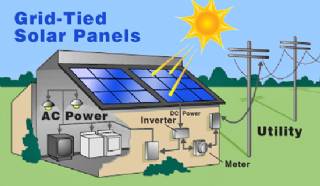
Solar Energy Systems - Solar Inverter - Solar Panel Inverter
Most grid-connected inverters can be installed outdoors, while most off-grid inverters are not weatherproof. There are essentially two types of grid-interactive inverters: those designed for use with batteries and those designed for a system without batteries.
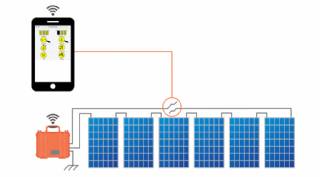
Solar Energy Systems - Solar Disconnects
Automatic and manual safety disconnects protect the wiring and components from power surges and other equipment malfunctions. They also ensure the system can be safely shut down and system components can be removed for maintenance and repair.
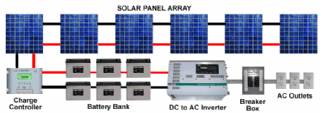
Solar Energy Systems - Solar Battery Bank
Batteries store direct current electrical energy for later use. This energy storage comes at a cost, however, since batteries reduce the efficiency and output of the PV system, typically by about 10 percent for lead-acid batteries. Batteries also increase the complexity and cost of the system.

Solar Energy Systems - Solar Charge Controller
A charge controller, sometimes referred to as a photovoltaic controller or battery charger, is only necessary in systems with battery back-up. The primary function of a charge controller is to prevent overcharging of the batteries. Most also include a lowvoltage disconnect that prevents over-discharging batteries. In addition, charge controllers pr
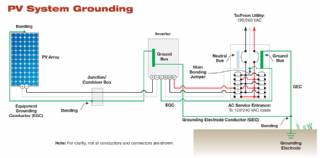
Solar Energy Systems - The NEC and PV Systems
Solar PV systems must be installed in accordance with Article 690 of the National Electric Code, which specifically deals with PV systems, as well as several other articles of the NEC that pertain to electrical systems in general. When there is a conflict between NEC 690 and any other article, NEC 690 takes precedence due to the unique nature of PV